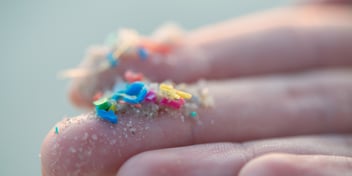More needs to be done to address microplastics found in water
Recent tap water testing conducted in the US and Europe has revealed microplastic fibre contamination in over 83% of samples, confirming plastic is not only a concern for ocean environments – but for human health as well.
Although the results of the Orb Media investigation are troubling, UNSW Senior Research Associate Dr Mark Anthony Browne said the time to start focusing on industry collaboration to address the problem is long overdue, as knowledge of microplastic fibre contamination has been readily available for many years.
“I don’t think this study is a huge advance in terms of our understanding; we have always known there are plastic fibres present in drinking water,” Browne said.
“Wherever I’ve worked around the world, including Australia, we routinely have to clean our apparatus when we are looking for microplastics. We use tap water and before we do we have to filter it because it is well known we always find fibres coming out of the tap.”
In 2001 Browne led a study assessing plastic pollution in oceans and found that microplastic fibres from synthetic clothing were the most abundant form of plastic contamination on the shores worldwide, as opposed to microbeads or other plastic product materials.
“Using forensic and sampling techniques, we traced it all the way back through wastewater and sewage outputs, which had been contaminated by clothes in washing machines,” he said.
Browne said that while water utilities are automatically implicated in drinking water contamination, microplastic fibre concerns will not be mediated without taking a close look at how to intercept the problem.
“I have approached companies in the Australian water sector in the past and they didn’t want to get involved. We are now in 2017, further down the line, and people are asking me how to solve the problem,” Browne said.
“The only way we can solve this is if people in these industries start working with us to understand and reduce the problem. Unless the Australian water sector gets on board and tries to have a proper look at this issue, it’s going to keep happening.
“As part of our Benign By Design Program, we have had dialogue with Australian water utilities about this, but we need to start scientifically testing how best to avoid [plastic contamination], how to intercept it and how to redesign products to solve it.”
While intercepting the issue at the water treatment level is one way of approaching microfibre drinking water contamination, Browne said it’s also important to address the lack of regulation present in manufacturing of products and chemicals.
“We have to realise that we are using chemicals in a very stupid way, allowing people to produce them without proper safety tests and without adequate measurement of their infiltration into environments,” Browne said.
“There are 15,000 chemicals that go on to the market everyday, and only 0.3% of those have any form safety testing. And we are up to our one trillionth that’s been produced.”
Browne said that manufacturers should be required to take responsibility for their products as waste, rather than leaving the clean up in the hands of governments and utilities.
“Manufacturers have gotten away with producing these products and they have no responsibility over how to deal with it as waste. It’s a regulation issue,” Browne said.
“Wet wipes are a classic example of a producer that is not being held responsible for its product as waste. It’s pretty much a social support system for a company to be able to produce whatever they want and then the water utility, the taxpayer or environment has to foot the bill.”
Browne said that after years of research, he is concerned the problem will continue to be overlooked.
“I worry because the public is going to become desensitised to this issue and it’s going to become another doomsday scenario, whereas I tend to look at it as something that could be easily managed if we take time and resources to understand and reduce this problem,” Browne said.
“Unless we start to think about how you avoid, intercept and solve this problem, we are going to have it.
“I reiterate: when my team first identified this problem globally and in Australia in 2008, the water authorities didn’t want to know about the issue, didn’t want to get involved with research. But when you don’t have people collaborating on a particular problem, the problem gets worse and worse and worse and it is really frustrating.”
Take a look at the Orb Media investigation here.
Related podcast:
https://omny.fm/shows/australianwater/wilson-xu-on-detoxing-our-waterways

